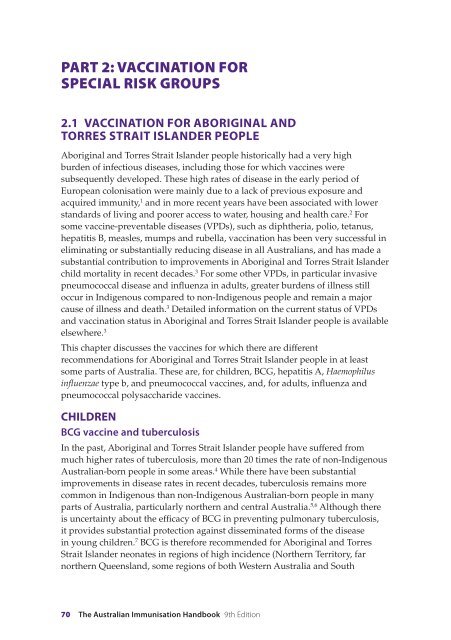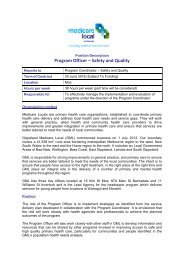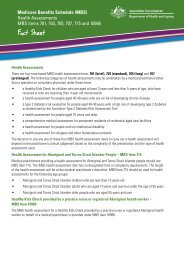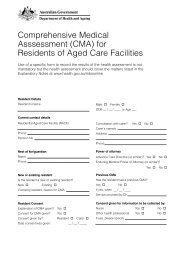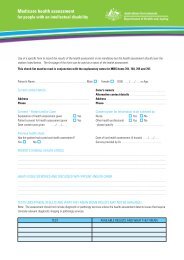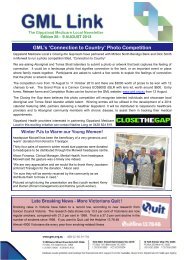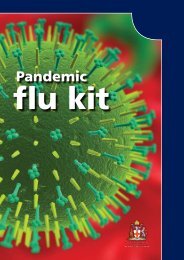Australian Immunisation Handbook 9th Edition - Goodstart Training ...
Australian Immunisation Handbook 9th Edition - Goodstart Training ...
Australian Immunisation Handbook 9th Edition - Goodstart Training ...
Create successful ePaper yourself
Turn your PDF publications into a flip-book with our unique Google optimized e-Paper software.
PART 2: Vaccination for<br />
special risk groups<br />
2.1 Vaccination for Aboriginal and<br />
Torres Strait Islander people<br />
Aboriginal and Torres Strait Islander people historically had a very high<br />
burden of infectious diseases, including those for which vaccines were<br />
subsequently developed. These high rates of disease in the early period of<br />
European colonisation were mainly due to a lack of previous exposure and<br />
acquired immunity, 1 and in more recent years have been associated with lower<br />
standards of living and poorer access to water, housing and health care. 2 For<br />
some vaccine-preventable diseases (VPDs), such as diphtheria, polio, tetanus,<br />
hepatitis B, measles, mumps and rubella, vaccination has been very successful in<br />
eliminating or substantially reducing disease in all <strong>Australian</strong>s, and has made a<br />
substantial contribution to improvements in Aboriginal and Torres Strait Islander<br />
child mortality in recent decades. 3 For some other VPDs, in particular invasive<br />
pneumococcal disease and influenza in adults, greater burdens of illness still<br />
occur in Indigenous compared to non-Indigenous people and remain a major<br />
cause of illness and death. 3 Detailed information on the current status of VPDs<br />
and vaccination status in Aboriginal and Torres Strait Islander people is available<br />
elsewhere. 3<br />
This chapter discusses the vaccines for which there are different<br />
recommendations for Aboriginal and Torres Strait Islander people in at least<br />
some parts of Australia. These are, for children, BCG, hepatitis A, Haemophilus<br />
influenzae type b, and pneumococcal vaccines, and, for adults, influenza and<br />
pneumococcal polysaccharide vaccines.<br />
CHILDREN<br />
BCG vaccine and tuberculosis<br />
In the past, Aboriginal and Torres Strait Islander people have suffered from<br />
much higher rates of tuberculosis, more than 20 times the rate of non-Indigenous<br />
<strong>Australian</strong>-born people in some areas. 4 While there have been substantial<br />
improvements in disease rates in recent decades, tuberculosis remains more<br />
common in Indigenous than non-Indigenous <strong>Australian</strong>-born people in many<br />
parts of Australia, particularly northern and central Australia. 5,6 Although there<br />
is uncertainty about the efficacy of BCG in preventing pulmonary tuberculosis,<br />
it provides substantial protection against disseminated forms of the disease<br />
in young children. 7 BCG is therefore recommended for Aboriginal and Torres<br />
Strait Islander neonates in regions of high incidence (Northern Territory, far<br />
northern Queensland, some regions of both Western Australia and South<br />
70 The <strong>Australian</strong> <strong>Immunisation</strong> <strong>Handbook</strong> <strong>9th</strong> <strong>Edition</strong>
Australia), where infants are at higher risk of acquiring this serious, and often<br />
fatal, condition. State and Territory guidelines should be consulted where BCG is<br />
being considered for neonates
Hepatitis A<br />
Hepatitis A infection has been shown to be very common in Aboriginal and<br />
Torres Strait Islander children across northern Australia. 13-15 Although the<br />
symptoms of infection in early childhood are usually mild or absent, cases<br />
complicated by liver failure and death have been reported among Indigenous<br />
children in far north Queensland 15 and the Kimberley 13 and recorded<br />
hospitalisation rates have been found to be at least 50 times higher in Indigenous<br />
compared to non-Indigenous children. 3 A vaccination program for Indigenous<br />
children was introduced in north Queensland in 1999, which resulted in<br />
substantial decreases in disease rates not only in Indigenous but also in non-<br />
Indigenous children, suggesting a substantial herd immunity effect. 16 Vaccination<br />
is now recommended for Aboriginal and Torres Strait Islander children in those<br />
jurisdictions with high incidence: the Northern Territory, Queensland, South<br />
Australia and Western Australia (see Chapter 3.5, Hepatitis A). Two doses should<br />
be given, commencing in the second year of life. As the exact recommended<br />
ages of administration vary between States and Territories, jurisdictional health<br />
authorities should be contacted about their vaccination schedules.<br />
Pneumococcal vaccines<br />
Some of the highest rates of invasive pneumococcal disease (IPD) ever reported<br />
in the world were in young central <strong>Australian</strong> Aboriginal children before the<br />
availability of the conjugate vaccine, 17 and very high rates were also reported<br />
in Indigenous children in other parts of northern Australia. 18,19 High rates of<br />
pneumococcal pneumonia have also been documented in central <strong>Australian</strong><br />
children, 20 and Streptococcus pneumoniae has been implicated in the high rates of<br />
otitis media. 21 In response to this, the 7-valent pneumococcal conjugate vaccine<br />
(7vPCV) was made available for Aboriginal and Torres Strait Islander children<br />
from 2001. As well as higher rates of IPD, a wider range of serotypes is responsible<br />
for disease in Aboriginal and Torres Strait Islander children, resulting in a lower<br />
percentage of cases (below 60%) caused by serotypes included in the 7vPCV. 18,19<br />
Therefore, a booster dose of 23-valent pneumococcal polysaccharide vaccine at<br />
18–24 months of age, following the primary course of 7vPCV, is recommended in<br />
areas of high incidence, ie. the Northern Territory, Queensland, South Australia<br />
and Western Australia. See Chapter 3.15, Pneumococcal disease for more information.<br />
There has been a rapid decline in invasive pneumococcal disease in Indigenous<br />
children since the introduction of the pneumococcal vaccines in 2001. 22<br />
ADULTS<br />
Influenza<br />
Influenza and/or pneumonia is the primary cause of around 2.5% of deaths in<br />
Aboriginal and Torres Strait Islander people, the vast majority being adults. 2<br />
The disease burden is greatest in the elderly, with hospitalisation and death<br />
more than twice as frequent in Indigenous adults aged ≥50 years, compared<br />
72 The <strong>Australian</strong> <strong>Immunisation</strong> <strong>Handbook</strong> <strong>9th</strong> <strong>Edition</strong>
to non-Indigenous adults. 3 Younger Indigenous adults suffer an even greater<br />
relative burden than non-Indigenous younger adults, at least 7 times higher<br />
for hospitalisations, and 28 times higher for death, 3 probably related to a high<br />
prevalence of risk factors such as diabetes, renal disease and excessive alcohol use. 2<br />
The most common complication of influenza is secondary bacterial pneumonia,<br />
and influenza vaccine has been shown to be effective in preventing pneumonia<br />
and death in the elderly. 23 Therefore, yearly influenza vaccination is<br />
recommended for all Aboriginal and Torres Strait Islander adults aged ≥15 years.<br />
Pneumococcal polysaccharide vaccine<br />
Studies in far north Queensland and the Kimberley have demonstrated a<br />
favourable impact of the 23-valent pneumococcal polysaccharide vaccine<br />
(23vPPV) on rates of invasive pneumococcal disease in Indigenous adults, 18,24,25<br />
but, at a national level, disparities in disease rates between Indigenous and non-<br />
Indigenous adults remain. As is the case for influenza and pneumonia, rates of<br />
invasive pneumococcal disease are highest in older Indigenous adults, with rates<br />
around 4 times higher in Indigenous compared to non-Indigenous adults aged<br />
≥50 years. 3 Rates in younger adults are slightly lower, but the relative difference<br />
between Indigenous and non-Indigenous is much greater, around 12 times higher<br />
in Indigenous compared to non-Indigenous adults aged 25–49 years. 3 This has<br />
been attributed to a high prevalence of at-risk conditions such as diabetes, renal<br />
disease and excessive alcohol use. 26<br />
23vPPV is recommended for all Aboriginal and Torres Strait Islander people<br />
aged ≥50 years, and for those aged 15–49 years who have high-risk underlying<br />
conditions, and has been funded nationally for people in these categories since<br />
1999. Eligibility for Indigenous adults may be broader than this in some regions;<br />
jurisdictional health authorities should be contacted for further information. A<br />
single revaccination is recommended after 5 years, and a second revaccination is<br />
recommended in some circumstances. See Chapter 3.15, Pneumococcal disease for<br />
more details.<br />
Other vaccines<br />
The first ever outbreak of Japanese encephalitis (JE) in Australia occurred in the<br />
remote outer islands of the Torres Strait in 1995. JE vaccine was first offered to<br />
the residents of these islands in late 1995 and, since then, the vaccine has been<br />
integrated into the childhood vaccination schedule commencing at 12 months of<br />
age (see Chapter 3.10, Japanese encephalitis). 27<br />
Service delivery<br />
General Practitioners, Aboriginal Community Controlled Health Services,<br />
Community Health Services, the Royal Flying Doctor Service and State/Territory<br />
Corrective Services all provide substantial levels of vaccination services to<br />
Aboriginal and Torres Strait Islander people, and are important to the success of<br />
programs to vaccinate Indigenous people. While vaccination coverage estimates<br />
2.1 Vaccination for<br />
Aboriginal and Torres<br />
Strait Islander people<br />
Vaccination for Aboriginal and Torres Strait Islander people 73
vary over time and between communities, a relatively consistent finding<br />
has been higher coverage in Aboriginal and Torres Strait Islander people in<br />
remote compared to urban areas. 28,29 Recent estimates suggest that, for vaccines<br />
recommended for both Indigenous and non-Indigenous people, coverage is as<br />
high or higher in Indigenous people as non-Indigenous people, 3 but vaccination<br />
is more frequently delayed. 30 Coverage for vaccines recommended only for<br />
Aboriginal and Torres Strait Islander people is generally lower than for vaccines<br />
which are funded for all people in a particular age group. 31 This points to the<br />
importance of identification of Indigenous status, particularly in mainstream<br />
health services, and particularly in urban areas. The use of patient information<br />
systems to record Indigenous status and schedule preventive health services has<br />
the potential to increase opportunistic vaccination and enable the provision of<br />
patient reminders, with improved coverage and timeliness. 32<br />
References<br />
Full reference list available on the electronic <strong>Handbook</strong> or website<br />
http://immunise.health.gov.au.<br />
74 The <strong>Australian</strong> <strong>Immunisation</strong> <strong>Handbook</strong> <strong>9th</strong> <strong>Edition</strong>


